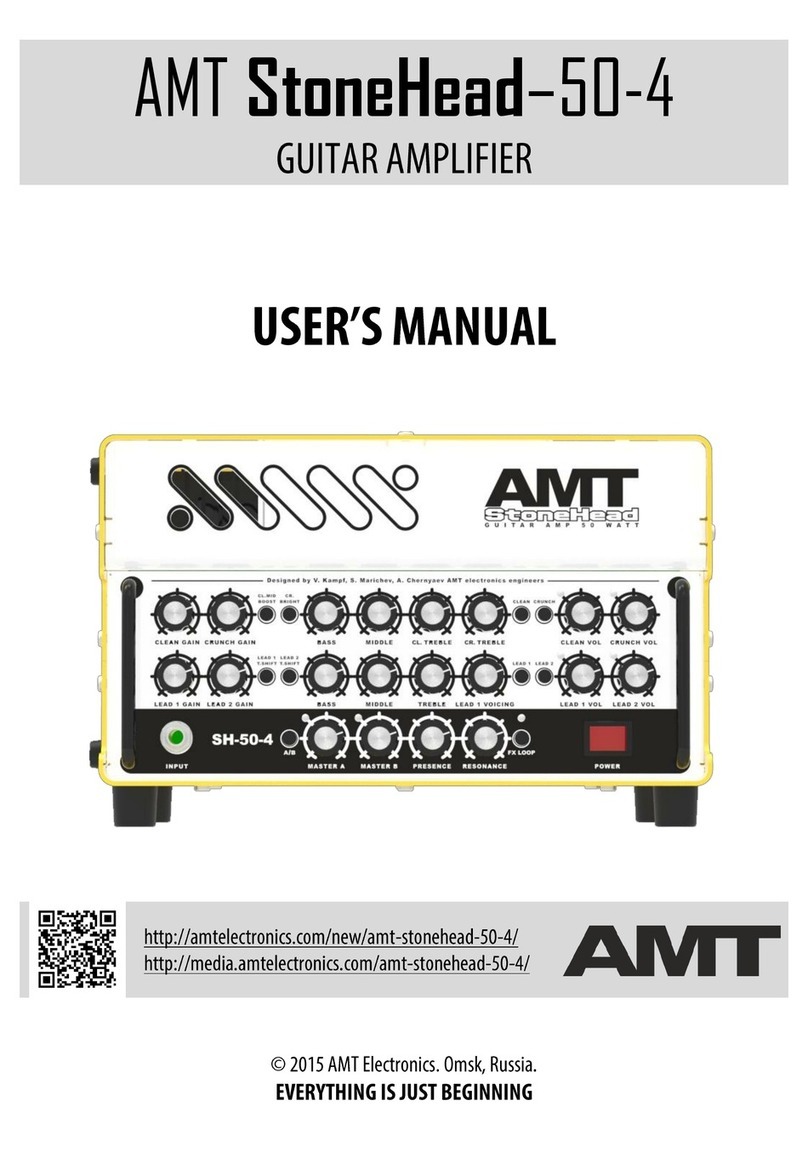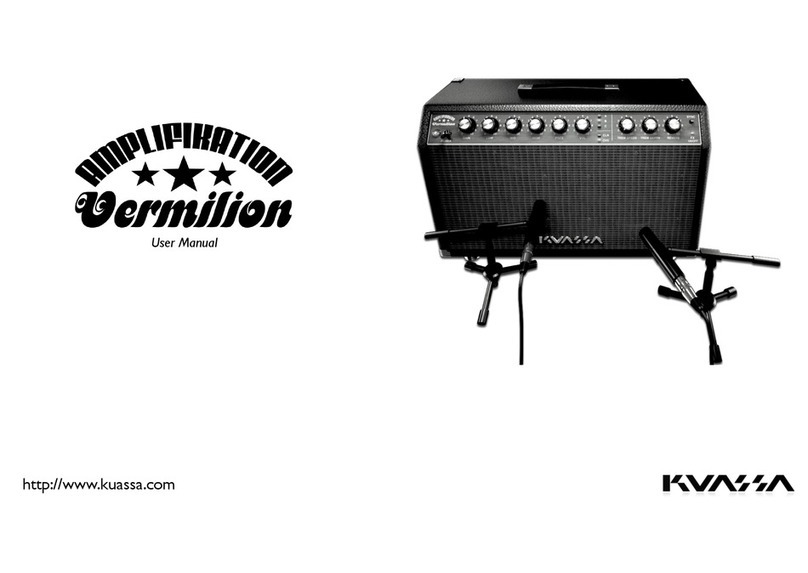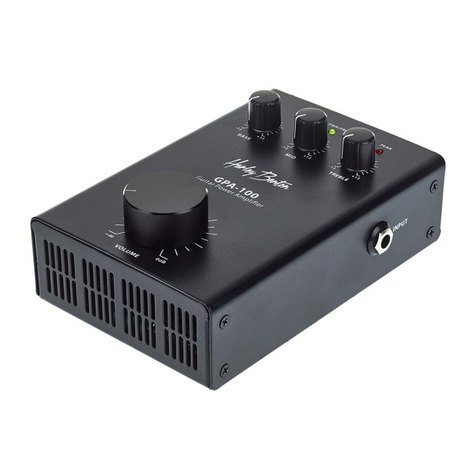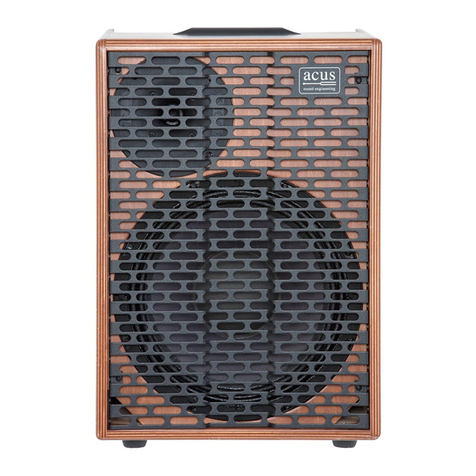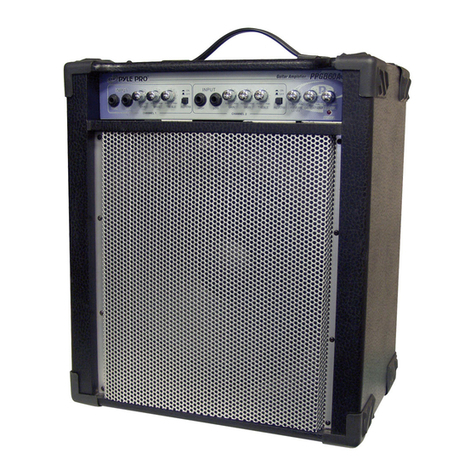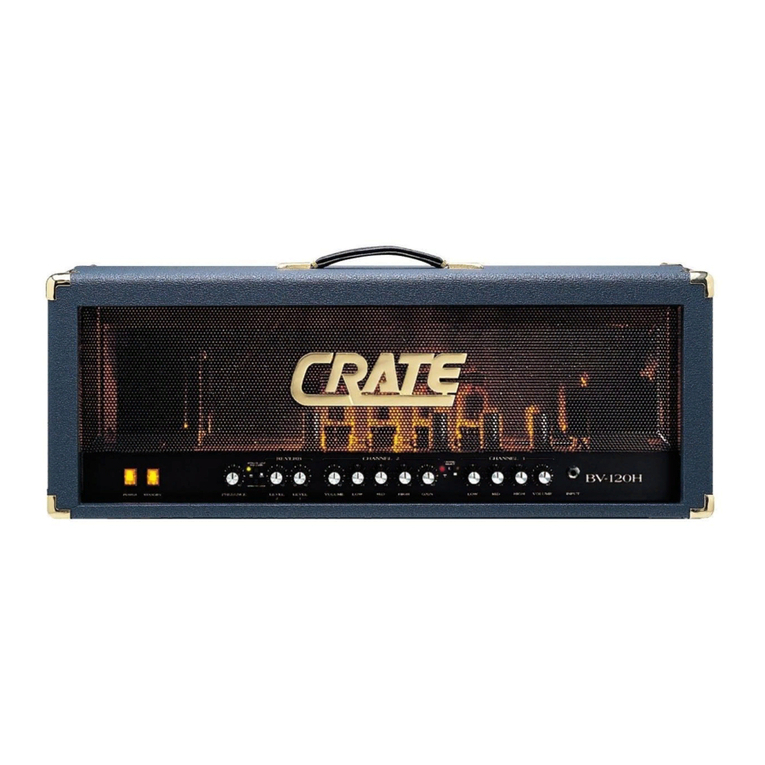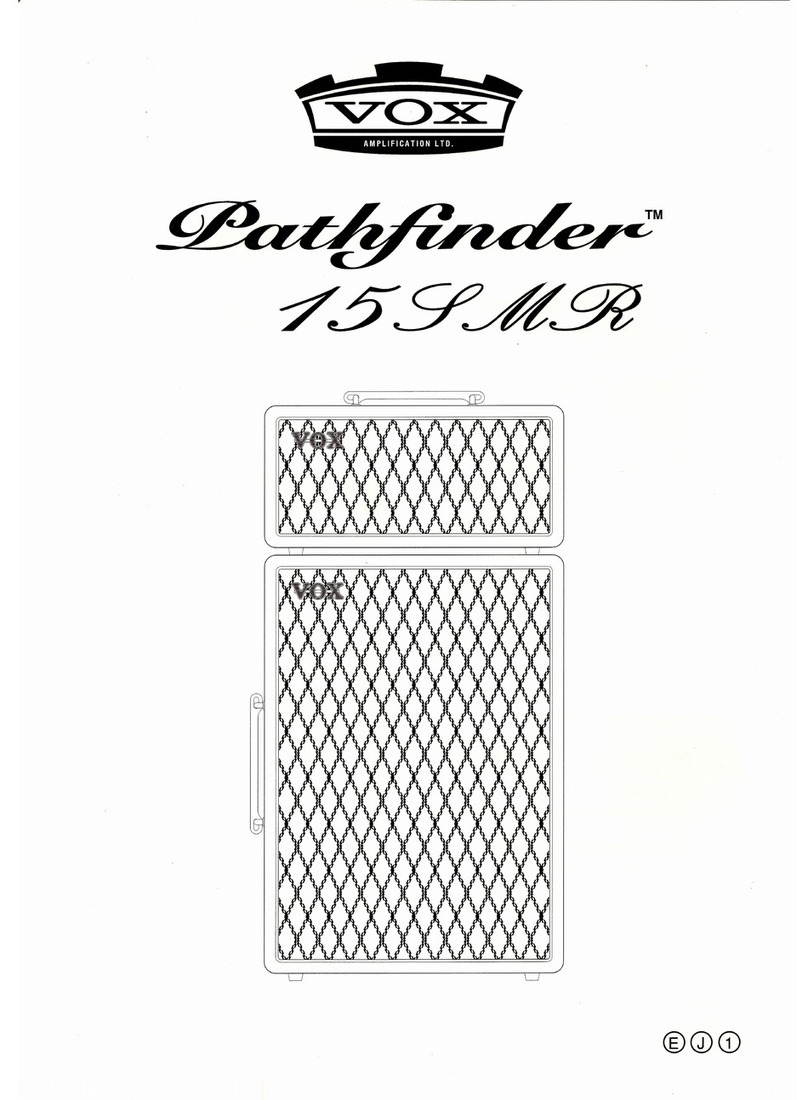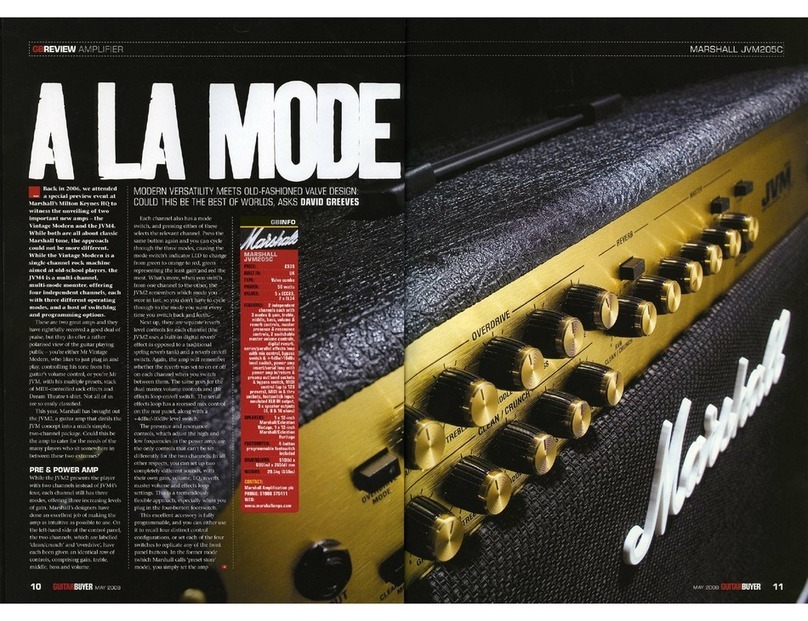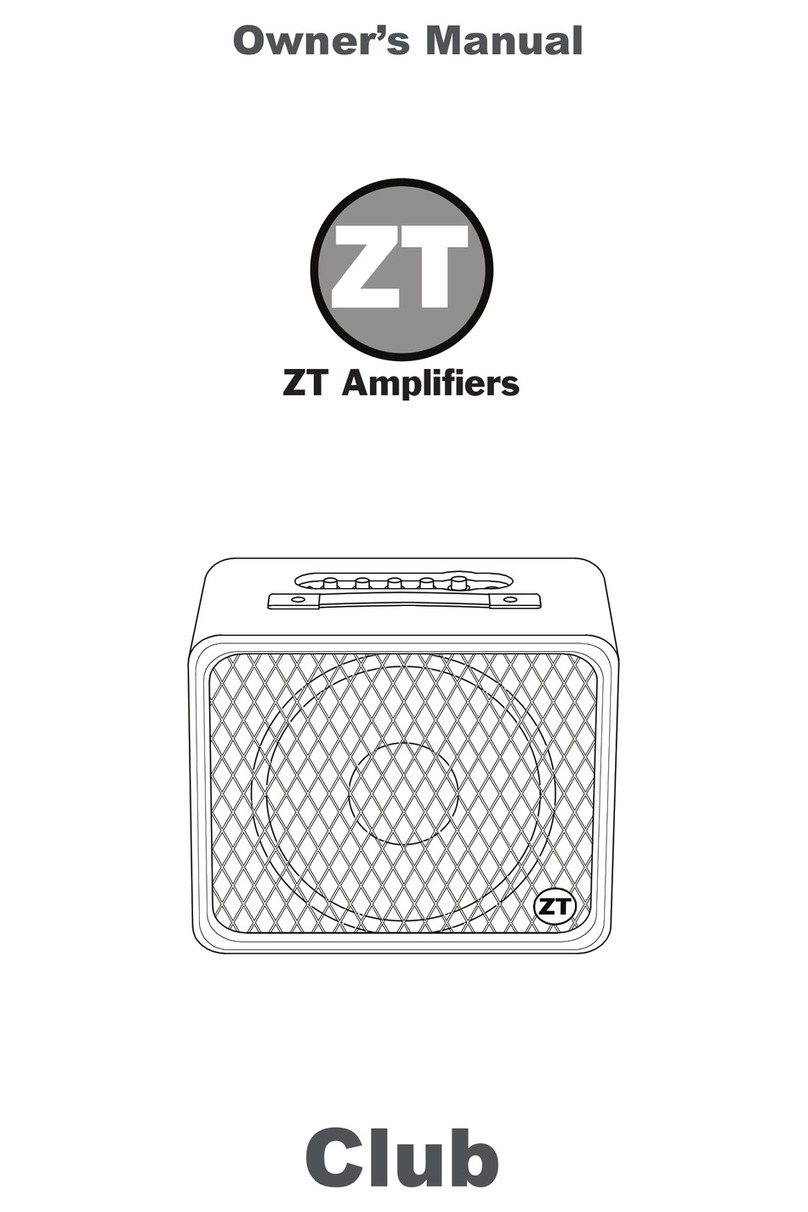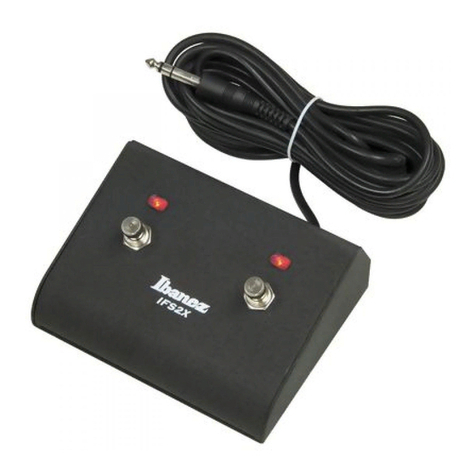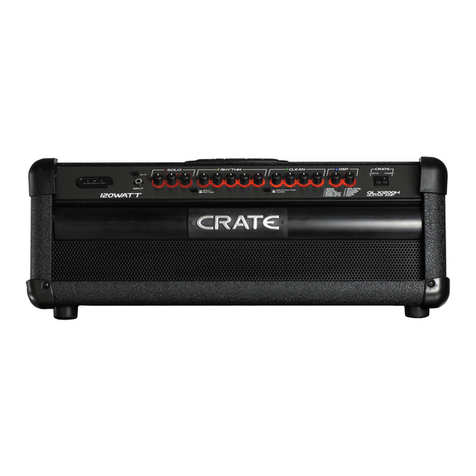Prolude Amplification KO750 User manual

PROLUDE AMPLIFICATION
KO750
KO750KO750
KO750
Bass amplifier
User’s manual

1—2

1—3
Table of contents
1
INTRODUCTION................................................................................................................................1—4
1.1
S
OME WORDS TO THE
C
USTOMER
....................................................................................................1—4
1.2
S
OME WORDS ABOUT ME
...................................................................................................................1—4
2
SAFETY INSTRUCTIONS, WARNINGS........................................................................................2—5
2.1
B
ASIC PRECAUTIONS
.........................................................................................................................2—5
2.2
W
ARNINGS USED ON THE AMP
..........................................................................................................2—5
2.3
G
ROUNDING INSTRUCTIONS
..............................................................................................................2—5
2.4
CE
MARK FOR
E
UROPEAN HARMONISED STANDARDS
....................................................................2—5
3
SPECIFICATIONS..............................................................................................................................3—6
4
INFORMATION FOR INSTALLING ..............................................................................................4—7
5
CONTROLS AND FUNCTIONS.......................................................................................................5—8
5.1
T
HE FRONT PANEL
.............................................................................................................................5—8
5.2
R
EAR PANEL
.....................................................................................................................................5—11
5.3
B
LOCK DIAGRAM
.............................................................................................................................5—12
5.4
O
THER FUNCTIONS
,
PROTECTIONS
.................................................................................................5—12
6
MAINTENANCE, CLEANING .......................................................................................................6—14

1—4
1 Introduction
1.1 Some words to the Customer
Welcome to the club of Prolude Amplification owners! It is my pleasure to have you as a member in this
small team of people who have taken notice of my handwork and intellectual product, and finally have voted
for it. I hope you will feel the same as they do while your amplifier, this small part of your musical production
chain, is reliably working behind you.
1.2 Some words about me
My name is Róbert Fülöp. My favourite musical instrument is the bass guitar. Its sound, shape and role
within the music have all contributed to my enthusiasm. To start with, my studies and my sphere of interest
have both moved me to the direction of electronics. As a result PROLUDE AMPLIFICATION was born at the
beginning of the new millennium. My goal is to provide bass players with the best possible sound quality.
Being an electrical engineer I’m doing it mainly with a technical mindset. However - according to the
feedbacks from my satisfied customers – the musicality is also present in the final product.
The technical development has been a long process so far - end it will never come to an end. I will make
further efforts to improve the product, thus satisfying the steadily changing expectations of the customer.

2—5
2 Safety instructions, warnings
2.1 Basic precautions
WARNING - When using electrical products, basic precautions should be followed, including the following:
Read all the instructions before using the product.
Do not use this product near water – for example, near a bathtub, washbowl, kitchen sink, in a wet basement
or near a swimming pool.
This product may cause permanent hearing loss. Do not operate for long periods of time at a high volume
level or at any level that is uncomfortable.
Make sure nothing interferes with the ventilation of the product when in use.
The product should be located away from heat sources such as radiators, heat registers, or other products
that produce heat.
The product should be connected to a power supply of the type described in the operating instructions or as
marked on the product.
The power supply cord of the product should be unplugged from the outlet when left unused for a long period
of time.
Care should be taken so that objects do not fall and liquids are not spilled into the enclosure through
openings.
The product should be serviced by qualified personnel when:
- The power supply cord or the plug has been damaged; or
- Objects have fallen, or liquid has been spilled into the product; or
- The product has been exposed to rain or moisture; or
- The product does not appear to operate normally or exhibits marked change in performance; or
- The product has been dropped, or the enclosure damaged.
10. Do not attempt to service the product. All servicing should be referred to qualified service personnel.
11. For continued protection against the risk of fire, replace fuses only with those of the same type and
rating.
2.2 Warnings used on the amp
The lightning flash with the arrow head symbol
within an equilateral triangle is intended to
alert the user to the presence of uninsulated
‘dangerous voltage’ within this product’s
enclosure that may be of sufficient magnitude
to constitute a risk of electric shock.
The exclamation point within an equilateral triangle is intended to alert the user to the presence of important
operating and maintenance (servicing) instructions in the literature accompanying this product.
2.3 Grounding instructions
This product must be grounded (earthed). If it should malfunction or break down, grounding provides a path
of least resistance for electric current to reduce the risk of electric shock. This product is equipped with a
supply cord having an equipment grounding conductor and a grounding plug. The plug must be plugged into
an appropriate outlet that is properly installed and grounded in accordance with the local codes and
ordinances.
DANGER - Improper connection of the equipment grounding conductor can result in a risk of electric shock.
Check with a qualified electrician or serviceman if you are in doubt as to whether the product is properly
grounded. Do not modify the plug provided with the product – if it will not fit the outlet, have a suitable outlet
fitted.
2.4 CE mark for European harmonized standards
The CE mark which is attached to these products means it complies with the EMC Directive (89/69/EEC),
CE mark directive (93/68/EEC) and Low Voltage Directive (72/23/EEC).

3—6
3 Specifications
Type KO750
Description Bass amplifier
Mains voltage 230VAC 50Hz
Mains connecting device Standard mains cord
Inrush current limiter NTC
Power consumption Max. 900W
Output power
/100Hz continuous sine/
750W @2.66Ohms
550W @4Ohms
300W @8Ohms
Minimal load impedance 2.66Ohms
Bandwidth -+3dB@1W 15Hz-30kHz
Power amplifier Class D
Speaker output connectors Neutrik Speakon-Jack combo
NLJ2MD-H
Instrument input connectors Neutrik 6.3mm Jack
NMJ4HFD2
Input impedance Passive: 500kohms
Active: 43kohms
FX Return: 15kohm
Active Equalization
Low +/-12dB@40Hz
Low-Mid: +/-12dB@500Hz
Mid: +/-12dB @ Mid-freq: 800-3200Hz
High: +/-12dB 6kHz shelving type
Line out 500mVp@600Ohms
Phone 1.5Vp@50Ohms
Working temperature range 0-40°C
Storage temperature range -25-60°C
Cooling Fixed speed ventilator based on heatsink
temperature
Weight 2.5kgs
Dimensions Width: 301mm
Depth: 205mm, + 15mm knobs
Height: 60mm, + 5mm foot

4—7
4 Information for installing
At high power level it is necessary to consider the wiring between the amplifier and speaker cabinets.
In most cases the amplifier is placed on top of the speaker cabinet, therefore a very short speaker cable can
be used for connecting the two. This is very good, because the shorter and thicker the loudspeaker cable,
the better.
Do not use an instrument cable for connecting speaker cabinets!
Use high quality / Neutrik / SPEAKON-SPEAKON speaker cable with at least 2x1.5mm2 or more cross
section. They are reliable, robust and have less influence on the sound.
Use a speaker cable in good condition and connect the speaker cabinet to the amplifier before you switch on
the amplifier.
Try to minimize the number of power strips used to connect the amplifier to the mains.
Use high quality, shielded instrument cable for connecting your instrument to the amplifier.
At high volume level the speaker cabinet might vibrate, so make sure that the placing is stable and the
amplifier can not move anywhere.

5—8
5 Controls and functions
5.1 The front panel
5.1.1 Active
Input jack for active instruments.
5.1.2 Passive
Input jack for passive instruments
Note:
There is no significant difference between the two inputs other than the input impedance and sensitivity. The
passive instruments and the preamplifierless piezo pickups „prefer” the Passive input, because of its higher
impedance and sensitivity.
5.1.3 Gain
This controls the overall signal level of the preamplifier section. Various instruments produce different signal
levels. The Gain control helps you to set these to the ideal signal level for the preamplifier section.
The two colour / green – red / LED – placed right from the Gain knob - is your feed back to set best signal
level.
The Gain setting is OK, if the LED is blinking between green and red. It is OK to go red when you make a
powerful plucking.
Note:
The setting described above is not a rule. Adding more Gain will not cause any problem. In such a case you
get a larger signal level with some drive. In some situations this can sound good. At this point you have to
consider the power handling of your speakers, because the overdriven sound strains them more.
If you set the Gain too low the preamp section will not send enough signal to the power stage and the output
power may be not enough and may also detain the proper functioning the Compressor.
5.1.4 Bright
Boosts the highs adding brightness to your sound.
5.1.5 Shape
Mildly boosts the lows and highs whilst cutting the mids. You can switch on this function also with the first
button of the Footswitch. In this case, however, the button on the front panel has to be in inactive position.
5.1.6 Boost
Activates the Boost channel.
The Drive knob controls the signal level in the distortion section, while the Tone gives a possibility to control
the overall color of the distorted signal.
If you turn left from the center position then get a deep rich warmer sound and moderate mids, or turn right to
get dominant mids.
The Level is intended to set the Boost channel's volume.

5—9
5.1.7 Active Equalization (High, Low-Mid, Mid-Freq, Mid, High)
Four band active equalization system with Low, Low-Mid, semi-parametric Mid and High controls. If you
leave the knobs centered, you get a linear, uncoloured sound.
You can bypass this feature with the second button of the footswitch.
5.1.8 Comp
Dynamic compressor. At the lowest position of the potentiometer this feature is inactive. By turning up it
produces more gain and simultaneously brings down the threshold level, where the limitation starts.
Generally, the softer playing gets more gain, than the louder. The limitation area is feed back by the blue
LED placed left to the Comp knob.
5.1.9 Volume
Controls the overall volume of the Speaker Outputs. The Line-Out and the Phone are not affected by this
potentiometer.
5.1.10 Mute
Mutes the Speaker Outputs, the Phone and the Line-Out. If the button is pressed, the red LED is bright.
Note:
This Mute LED gives you additional information too, see section 5.1.16.
5.1.11 Phone
Phone output drives stereo headphones / in mono mode /. Its volume can be controlled by the Gain
potentiometer.
5.1.12 Foot Sw.
Footswitch input. You can connect a two-buttons footswitch here via a stereo jack cable.
You can activate the Boost channel or Shape function with the first button and bypass the Active
Equalization by the second one.
Note:
To set the function of the first button, see section 5.4.8.
5.1.13 DI (Line Out)
Balanced Line Out with Neutrik XLR connector. It gives a high quality line level signal to be used for PA or a
recording system. The button disconnects pin 1 of the XLR connector.
Note:
In most cases the button has to be unpressed! When you get ground loop, hum or buzz while connecting to
PA or a recording system pressing the button may help to eliminate this.
The Phone output provides an unbalanced, higher signal level. You can use it also for connecting to a
computer’s soundcard.

5—10
5.1.14 On
You switch on the amplifier with this switch. After switching on there is a ventilator test for about 4-5
seconds, after which the amplifier is in ready mode.
Note:
At the end of the ventilator test you will hear a tiny pimple from the speakers connected. It is normal.
Important:
Please avoid switching on and off the amplifier too often, especially after playing at high volume level! After
playing at high volume level give the ventilator a few minutes to cool down the amplifier before switching it
off!
5.1.15 Mute LED
Multifunctional feedback LED.
Bright when:
- the Mute button is pressed;
Or if unpressed:
- after switching on, during the ventilator test
- when the power stage is overheated

5—11
5.2 Rear panel
5.2.1 Mains
The mains appliance inlet. You must use standard earthed mains cord.
Important!
This equipment should only be connected to 230VAC, 50Hz mains network!
The mains plug must be plugged into an appropriate outlet that is properly installed and grounded!
5.2.2 Speaker Outputs
Neutrik Speakon-Jack combo outlets. They are connected parallel inside the amplifier. Both of speakon or
6.3mm jack plugs are suitable to connect speaker cabinets.
The minimum load impedance should not be less than 2.66ohms.
Note:
The speakon connector is a more stable, robust and reliable solution. Use this - if you have one - instead of
jack! Avoid long speaker cables and low quality plugs in order to maintain sound quality and volume.
The amplifier can be used without speakers as well.
Warning!
There is dangerous voltage on the speaker output! Connect the cabinets to the amplifier before switching on
and do not touch the hot pole of the speaker jack!
5.2.3 Ventilation cutouts
Do not cover the ventilation cutouts! Insufficient ventilating causes overheating, which can cause permanent
damage to the power stage.
Note:
Overheating or fault of power stage is displayed by the Mute LED.
If this occurs, switch off the amplifier, wait for 30 minutes before then switching it on again! If the Mute LED
stays lit after the ventilator test /2-3 seconds/ then the amplifier has to be brought to a qualified technician for
repair.

5—12
5.3 Block diagram
5.4 Other functions, protections
5.4.1 Short circuit protection
The amplifier contains a protection circuit against wrong / shorted / speaker cable or burnt speakers.
5.4.2 Speaker protection
This circuit stops the power supply when power stage fault occurs, protecting the cabinets from harmful
direct current.
5.4.3 Overheat protection
Due to insufficient ventilation, ventilator fault or too high environment temperature while playing at high
volume, overheating may occur. In such a case the protection circuit detaches the speaker cabinets until the
temperature of the power stage cools down. This is being displayed by the Mute LED.
Input
stage Preamp
Boost Shape
Comp. Speaker
Prot.
Volume
Control Power
Amp.
Level
Det.
Line
Buffer
Phone
Amp.
Fan
Control
Active
Passive
Active Eq.
Gain
FS1: Boost / Shape
Drive, Tone,
Level Low, Low-Mid, Mid-
freq, Mid, High FS2
Mute Volume
GND Lift
Line Out
Phone Out
Overheat
Sense
Speaker
Out
Bright
Limiter
Shape
Phantom
power Boost

5—13
5.4.4 Ventilator control
The control of the cooling ventilator is based on the temperature of the power stage’s heat sink. It
automatically switches itself on when the temperature reaches 60°C and switches itself off when temperature
decrease below 50°C.
Do not cover the ventilation cutouts!
5.4.5 Limiter
This function protects the power section against distortion. When it detects distortion on the output,
decreases the input signal of the power stage. In practice, there is no significant distortion on the power
stage when you overdrive it, the system will only lose some of its dynamics.
5.4.6 Phantom power
You can activate the phantom power function in the amplifier to supply your active bass electronic connected
to Active input. So you do not need a battery in your bass.
Requirements:
- stereo instrument cable
- activate the phantom power by the DIP switch located on the bottom of the amplifier. The
settings are described in section 5.4.7.
- if your electronic does not support phantom power, you have to disconnect the battery and make
a short circuit on the battery clip in the bass.
Note:
The phantom power can supply 14.5V and max. 6mA. You get more headroom compared to the use of one
9V battery before. Make sure that your electronic circuit can handle more voltage than 9V. If not, you can set
only 9V on the DIP switch.
Warning:
If you use this function, pay attention that you Mute the amplifier before plug in or out the instrument cable.
5.4.7 DIP switches
The DIP switches are located on the bottom of the amplifier. You can set these functions:
1. if ON, the Boost channel can be activated by the first button of the Foot Switch
2. if ON, the Shape can be activated by the first button of the Foot Switch
3. if ON, this activates the phantom power
4. if ON, the phantom power supplies only 9V instead of 14.5V
Note:
If both switch 1. and 2. are ON, then you can switch on both of the Boost channel and Shape.

6—14
6 Maintenance, cleaning
The amplifier has no need for particular maintenance.
Occasionally check the starting of the ventilator when you switch on the amplifier!
Use only soft and dry or dampened cloth for cleaning. Avoid aggressive, caustic cleaning materials.

6—15
Budapest, 2014.03.27.
Table of contents
Other Prolude Amplification Musical Instrument Amplifier manuals

